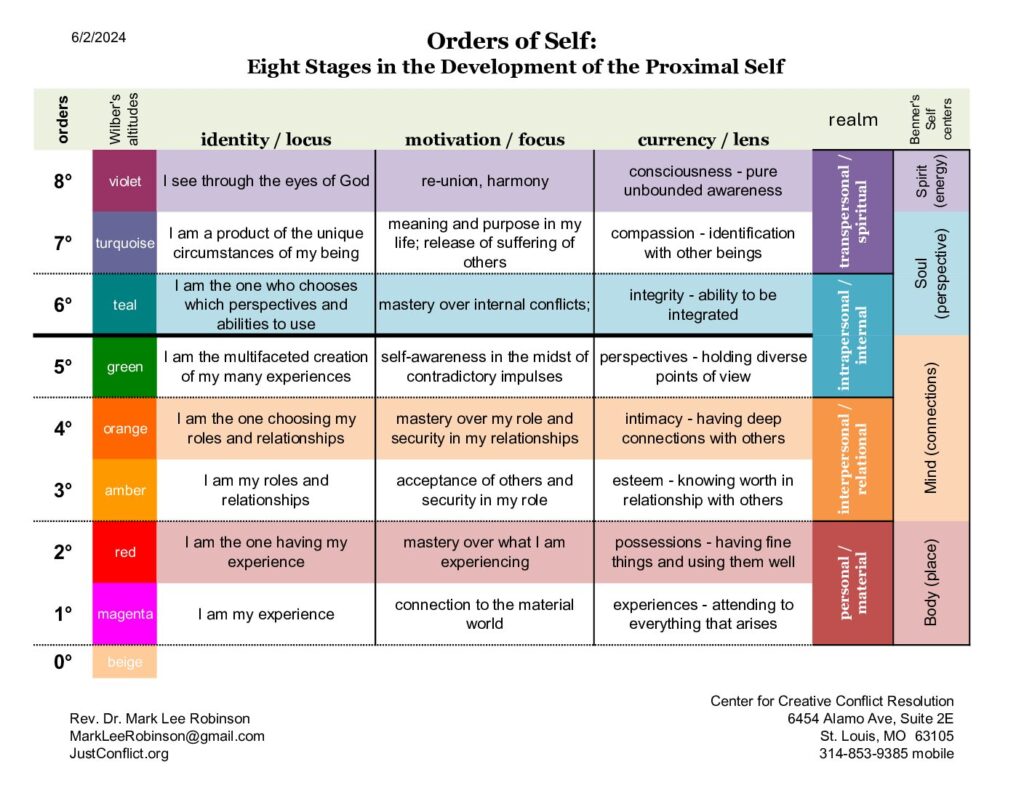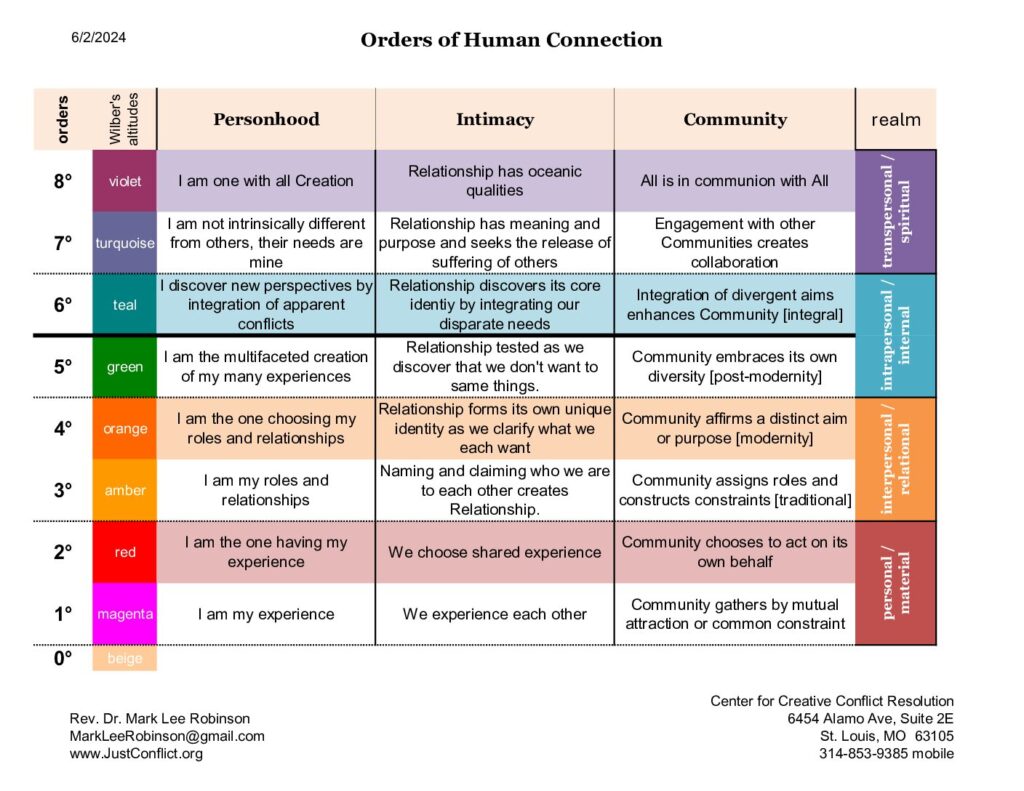Eight Orders of Being: Four Realms with Two Aspects Each
Fundamental to any integral philosophy or practice is the application of developmental maps. My own introduction to integral theory was propelled by the discovery of Spiral Dynamics. I was already familiar with James Fowler’s Stages of Faith, Erik Erikson’s stages through the human life cycle and Jean Piaget’s stages of cognitive development. Somehow the attention to cultural development, the addition of a spiral component, and the tantalizing idea that there is a second tier which awaits us, grabbed me, and wouldn’t let go. Can we envision and begin to live into a collective way of being?
There are twenty pages in the appendix of Wilber’s Integral Psychology in which he posts various maps and lines them up to visually show how they correlate to each other. This array inspired me to begin to imagine a developmental map that might best support my work as a psychotherapist. The result is what I have come to call the Eight Orders of Self. This is a map of the development of the proximal self as it unfolds over a lifespan. It is particularly valuable for helping folks see where they are developmentally stuck, and what could arise for them as they resolve their current life issues.
As integralists we each have our own favorite developmental map. These are very handy tools. But it makes it hard to talk to each other when we reference different maps. When I observe that some issue is characteristic of Fourth Order, I don’t know that what I mean by Fourth Order is what others mean. To communicate clearly, we must translate into a language that is shared, so we use Spiral Dynamics, or maybe Gebser or Loevinger, or whoever we think the other will be most familiar with.
At some point the integral community may settle on a universal map. I want to offer some suggestions about what we will want to consider as we find “the best map.”
A map is just a map. The map is not the territory. We cannot fully know what is real, but we can have ways of talking about what is true such that we can approach the real. Our maps are “fingers pointing at the moon.”
A map can be a tool for transformation. Any map will answer three questions. It will help us see where we are; it will help us know where we might be; and it will help us know what we need to do to get there. The best maps help us discover new ways of being and encourage us to live into them.
A map can help us solve problems by telling us what our circumstances mean. Humans are meaning makers. Cognitive maps are heuristics that allow us to readily make meaning.
A map is most helpful when it is comprehensive, simple, and useful. A good map will include and highlight all the relevant variables. At the same time, it will be simple enough to use easily. And however much the map may be meaningful, it must also give guidance about options for solving the problem.
Over the past few decades, I have assembled a map to use with my clients to help them see where they are in a larger process of developing a robust sense of themselves. I called early iterations of the map the “Eight Orders of Self.” It was primarily a tool for first constructing a resilient ego and then for transcending that ego.
But I began to see that it also illuminated the process by which couples create strong, intimate relationships, and how communities can grow in their ability to make wise decisions which create equity and justice. I have come to see that there is a deeper structure, and that structure is the nature of being itself.
I offer it to you for your consideration.
Four Realms of Being
A central feature of the “Perennial Philosophy” is the observation that religion posits a continuum between the material world and that of the spiritual. While this is an even and gradual gradient, it is easier for us to make sense of the continuum if we break it into a series of steps or stages.
Material/Personal
We easily and readily acknowledge the reality of the material realm. Indeed, there are a good many folks for whom the material or personal realm is the only reality. Sometimes disparaged as materialists, they reduce everything to that which can in some way be measured.
Relational/Interpersonal
Less tangible but still readily observed are the relationships between persons or things. We can see that the relationships themselves can have qualities and that the quality of a relationship can inform the way we encounter the physical world. Language is a property of the relational realm, and words can construct our understanding of the world in which we live.
Interior/Intrapersonal
At a point in early adolescence, we become able to think about how we think. We become aware of our awareness. We have an interior that we can observe and see that there are mental and emotional objects there. We have emotions and thoughts and no one else knows what they are unless we give voice to them in some fashion.
Spiritual/Transpersonal
At the top of the spectrum is the spiritual realm. Many folks, not knowing that they have themselves experienced this realm will deny its very existence. This is the dimension in which everything is connected to everything, everywhere, all the time.
Duality: every coin has two sides
This quality of being is hard to describe because it appears differently depending on the level of complexity at which it arises. One way I find myself referencing it is as the arising and the arousing. It is what happens, and the response to what happens.
At the fundamental physical level, matter and anti-matter pop into being and then disappear. At the level of Newton’s Law of Motion, every action has an equal and opposite reaction. Within human relationships we are cautioned to differentiate between what we have control over and what we do not… thus the Serenity Prayer.
In each realm of being there are emergent events and there are the occasions that become possible or necessary from what is emerging.
- In the material realm, because the weather has turned cold [1st Order], one may choose to wear a jacket [2nd Order].
- In the relational realm, because someone I feel an attraction to has shown interest in me [3rd Order], I am going to propose a date [4th Order].
- In the interior realm, because one is especially anxious when attractive women are angry with them [5th Order], one may recover the memory of the dance in high school when their beautiful date humiliated them in a very public way. One may acknowledge that wounded part and construct a strategy to confidently care for oneself in the future [6th Order].
Each odd numbered order is an arising… an emergence… that creates the occasion for a creative response which is the heart of the even numbered order that follows. There are two aspects to each of the four realms and thus eight orders.
Development through Orders of Being
Everything that grows does so in stages. Sometimes the stages are easily identified as in the development of an insect through the stages of egg, larva, pupa, and adult. But in the development of humans, the stages are less easily demarcated and there are many lines of development. Someone, for example, may have attained a high level of cognitive ability but not be very mature ethically.
In any given line of development there are certain tasks or competencies that must be met before one is able to move to a more mature stage. For this reason, there is a hierarchy to the stages, they come in a set sequence, and one cannot skip a stage. Each builds on the one before it. We mature by transcending the earlier stages while including their insights and abilities into the newly developing ones.
Each level or stage is more complex than the one preceding it. The work of attaining to the stage is worth it because it allows life to be experienced with greater clarity and thus living is simpler. While each subsequent stage is better than the previous ones, insofar as it is a better tool for living, this doesn’t mean that someone who has attained that stage is better. This is a hierarchy of complexity, not a hierarchy of value.
Sixth Order: Second Tier: Non-duality
You will see on the printed maps a dark line between 5th and 6th Order. This is the point at which systems evolve into a second tier, teal, double-bracket, non-dual mode of being. When applied to the evolution of consciousness, this is the birth of wisdom… it is putting on the Mind of Christ.
Transcendentals
Transcendentals are innate qualities or properties of being. We normally think of these as truth, goodness, and beauty. To illustrate the nature of the four realms and to show how they shape the way being is formed and informed, I have chosen four other transcendentals; love, freedom, justice, and time.
For more about the 8 Orders refer to the article at https://justconflict.org/summary/introduction-to-the-orders-of-self/
Rev. Dr. Mark Lee Robinson
314-853-9385
Attachments: Three versions of the map
Perhaps the best place to start is with the Orders of Self. A fuller explanation can be found here, but the map is duplicated here in a slightly different form.

This map focuses on the development of the consciousness of an individual human.
Orders of Being with Transcendentals

This map more broadly addresses the nature of being itself and includes hints as to how these four transcendentals arise differently at each realm.
Orders of Human Connection

This version of the map looks at the ways an individual person develops, how development looks in the context of an intimate relationship. and how communities can develop along these lines and stages.

